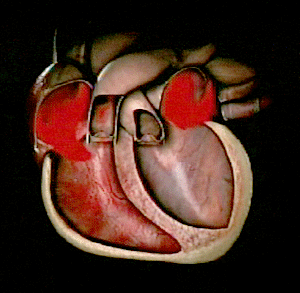

The circulatory system works hand-in-hand with the respiratory system. In the circulatory system, the most vital blood vessels include arteries, veins, & capillaries. Of course, the most important organs of the circulatory & respiratory system are the heart & the lungs.
The heart is a muscle about the size of your fist & includes four chambers (called the left & right atriums & ventricles), while its job is to pump blood throughout the entire body via blood vessels. A powerful four-chambered heart was an essential adaptation in support of the endothermic way of life characteristics of mammals and birds.
The Blood Flow:
1) superior/inferior vena cavas
2) right atrium
3) tricuspid valve ~ has 3 flaps
4) right ventricle
5) pulmonary valves
6) right & left pulmonary arteries
7) left atrium
8) mitral (or bicuspid) valve
9) left ventricle
10) aoritic valve
11) aorta
~ People always say that the heart pumps blood throughout the body to vital organs, making it one of the most important organs of the body. However, did you ever think that the heart needs blood itself to keep pumping blood? The veins and arteries that provide the heart with blood are called the coronary vessels. These vessels run along all sides of the heart - you can see them without slicing up the heart - and they are part of the systemic circulation.
~ IMPORTANT: Capillaries converge into venules and venules converge into veins. Arteries & veins are distinguished by the direction in which they carry blood, not by the characteristics of the blood they contain (with a few exceptions).
Respiration ~ the process of gas exchange of oxygen and carbon dioxide between the blood, the air, and tissues

~ The bronchioles subdivide into millions of tiny air sacs called alveoli.
~ The impulses that travel through cardiac muscle during the heart cycle produce electrical currents that are conducted through body fluids to the skin, where the currents can be detected by electrodes and recorded as an electrocardiogram (a.k.a. ECG or EKG).
~ Blood pressure, the main force driving blood from the heart to the capillaries, is highest in the arteries.
~ The pacemakers of most arthropod hearts originate in motor nerves arising from the outside, an arrangement called a neurogenic heart.
-
A defect in one or more valves causes a condition known as heart murmur, which may be detectable as a hissing sound when a stream of blood squirts backward through a valve. Most heart murmurs do not reduce the efficiency of blood flow enough to warrant surgery.

Add quiz HERE!
~ If we sit or stand too long, the lack of muscular activity causes our feet to swell with stranded blood that is unable to return to the heart. This is one of the many reasons to why being active is essential to our health!

~ Endurance is all about maintaining an elevated heart rate for an extended period of time (usually 20 min or more). Goals for endurance training include, but are not limited to, playing sports and decreasing body fat and/or cholesterol.
The Cardiovascular System!
